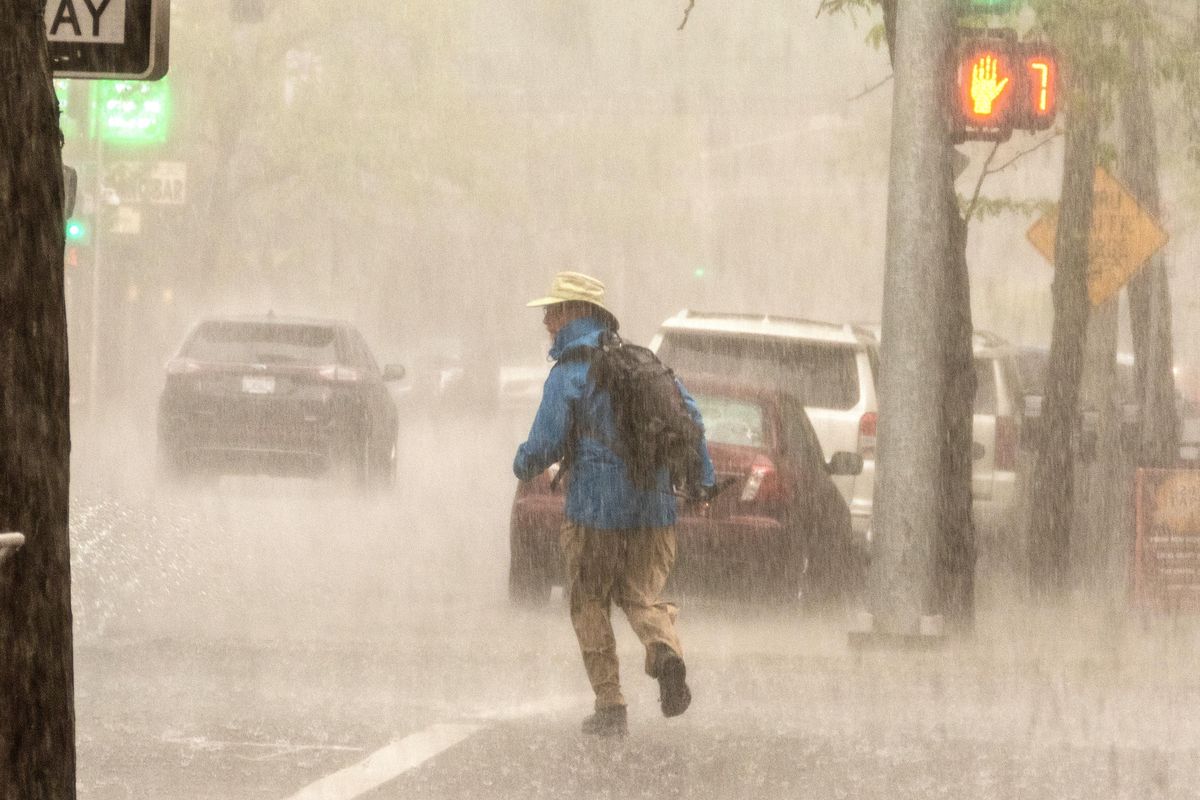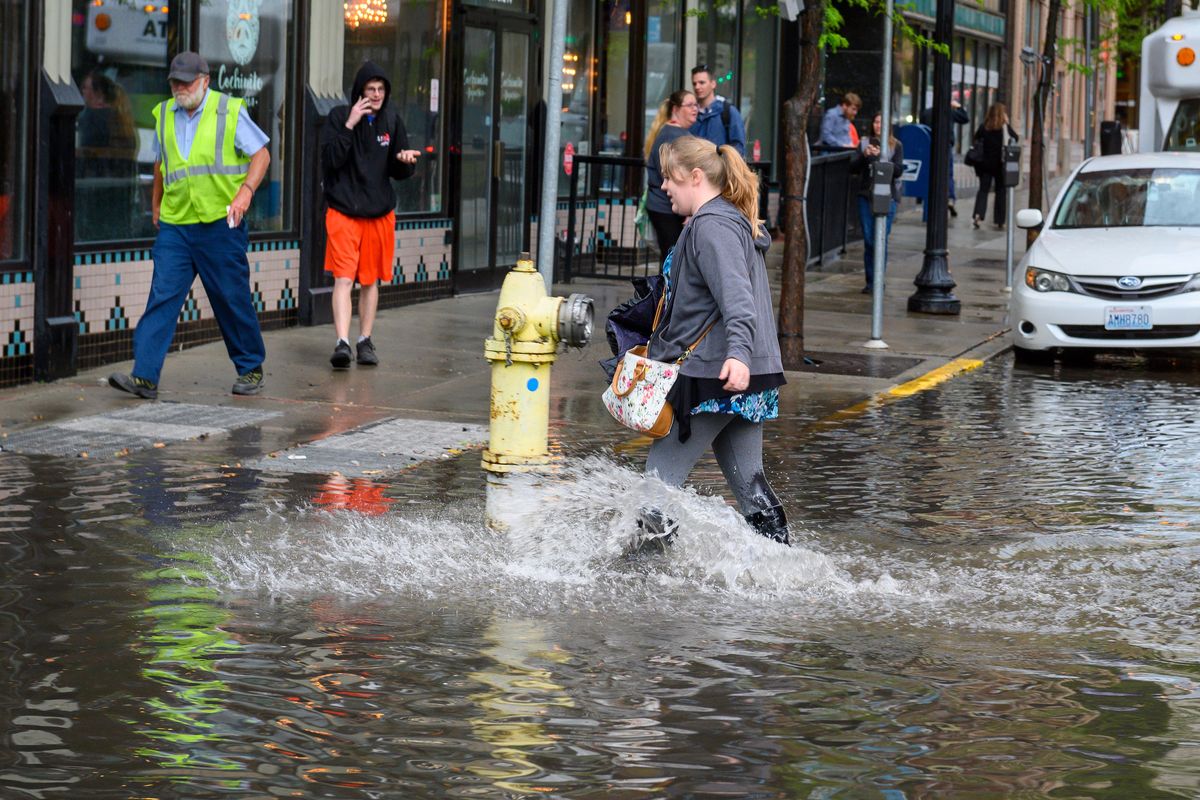Rain keeps falling Friday as city tries to clean up after downpour

Rain continued falling Friday as Spokane tried to dry out from storms that flooded downtown businesses and damaged streets during Thursday’s evening commute.
National Weather Service meteorologist Joey Clevenger said reports of damage seemed to be limited to Spokane.
Spokane International Airport received only 0.3 inches of rain on Thursday, and by Friday afternoon the 24-hour total had reached 0.71 inches.
But other areas were dumped on. Updated figures Friday afternoon showed 24-hour precipitation totals reaching 2.21 inches in Spokane’s West Central Neighborhood, 1.21 inches at Felts Field, 1.4 inches at Five Mile Prairie, 0.84 inches in Cheney and 1.08 inches in Post Falls.
Thursday’s deluge in low-lying areas while the West Plains remained dry is not uncommon in other flooding events in the Inland Northwest, according to past news reports.
A pair of cloudbursts in July 1990 and one year later, in July 1991, flooded streets downtown and swept away sewer lines near Latah Creek, while gauges at Spokane International Airport reported less than .2 of an inch of rain, according to reports in The Spokesman-Review.
A flood watch remains effective through 8 a.m. Saturday. Between 0.25 and 0.5 inches was expected Friday in Spokane.
A wall of water pounded the city starting at about 5 p.m. Thursday, causing widespread flooding to homes and businesses across the downtown core. Some city streets became small lakes as storm drains quickly became overwhelmed with water and debris.

The rapid rainfall, which hit hardest on the western and southern edges of Spokane, was an unprecedented test of the city’s new storage system to capture stormwater runoff before it mixed with untreated sewage and spilled into the Spokane River.
A few tanks and other newer forms of infrastructure, intended to overflow once a year during a 20-year period, failed that test.
“It looks like 10 spots overflowed. I was surprised that they didn’t all go,” said Marlene Feist, a spokeswoman for the city.
The city has invested about $200 million in subterranean storage tanks to capture rainfall. When that system is inundated, there are still relief valves, known as outfalls, where that water enters the river before being treated at Spokane’s wastewater treatment facility west of town.
Those relief valves prevent the city’s main sewer and stormwater pipe, known as an interceptor, from failing, which would cost the city millions of dollars to replace and prevent the treatment of millions of gallons of wastewater a day.
Shortly after the rain began falling, water began pouring out of the outfall pipes in some areas that were connected to the tanks. Those were limited to smaller tanks and those built before the city’s revision of its stormwater plan in 2012, Feist said.
“We know there’s going to be outliers, we looked at rain data over 12 years before making a determination on sizing,” Feist said. “You can’t build infrastructure big enough to handle that kind of rain, you would never be able to pay for it.”
Pipes that flowed into the river included ones connected to West Central, where crews last summer placed new plastic planters beneath the sidewalks that were expected to filter rainwater back into the ground. Water also spilled from pipes connected to a 2.2-million gallon tank buried on a plot next to KHQ-TV downtown, though Feist said all the calibrations hadn’t been finished on that tank yet.
The city of Spokane said on Twitter Thursday night that city wastewater crews would be out clearing streets for much of the night. The post was accompanied by a photo of city crews clearing drains as they stood submerged in large puddles.
The T.J. Meenach Bridge reopened just after midnight Friday after a washout spread debris all over the span connecting West Spokane to Spokane Falls Community College, Feist said. One southbound lane of T.J. Meenach Drive between Northwest Boulevard and the bridge remained closed as crews assessed damage from washouts, Feist said.
Downtown, the city closed the Post Street bridge Friday afternoon to vehicle traffic, citing a structural analysis, which found the aging span can’t safely hold that much weight. Pedestrians and bicyclists were still allowed, though sidewalks were closed.
The 333-foot reinforced concrete bridge was built in 1917 and carries a 54-inch sewer line.
A tweet Friday morning said crews were still out clearing debris. Many roads previously flooded seemed clear of standing water Friday, except for some roadways in low-lying areas.
Crews were working to clear the intersection of Fifth Avenue and Walnut Street on Friday afternoon, shutting down the Interstate 90 on-ramp there. The on-ramp was expected to reopen by the evening commute, the city said.
The debris plugged the city’s treatment system at the wastewater plant, causing water to be diverted that then spilled into the Spokane River, Feist said.
“I think that rain was pulling down every loose pine needle in the city,” she said.
City officials were reviewing data Friday about the stormwater system and how it reacted to the intense rainfall.
Spokane Public Schools reported some flooding complications. Rogers High School in the Hillyard neighborhood – one of the poorest schools in the district – was hit hardest.
At Rogers, classes began on time Friday morning, but the hum of industrial floor fans filled classrooms, hallways and even the office of Principal Lori Wyborney.
“It’s been quite a morning,” Wyborney said as workers cleaned and assessed the damage, including several interior walls.
Wyborney was at the school Thursday afternoon, preparing for an ROTC event.
“I was in the girls bathroom, getting ready for it, and I heard this huge bang,” she said.
Thinking that the building had been struck by lightning, Wyborney walked out to see water flowing down the main hallway and cascading down walls from the upper floors.
The damage was caused by stormwater that found its way into the drains with such volume and force “that it blew all the covers off,” Wyborney said. At least four drains were affected, she said.
In the Perry District on the lower South Hill, a water main ruptured Thursday, trapping a firetruck in a hole that opened in the roadway. Water from the main ran into two homes, causing substantial damage.
The burst main also left Grant Elementary School temporarily without running water. School district spokesman Brian Coddington said city officials expected water to be restored to the school early Friday. School started on time.
At Lewis and Clark High School, there was “very minor” flooding, Coddington said.
“Nothing that was too noteworthy,” Coddington said. “Very localized.”
Ryan Overton, a spokesman for the Washington Department of Transportation, said Friday afternoon he hadn’t heard any reports of damage to state highway infrastructure from the flooding. Aside from some drainage issues Thursday evening on Interstate 90, the storms had little effect, he said.
“We have not had anything yet, thankfully,” he said.
Spokesman-Review reporters Kip Hill, Jim Allen, Jonathan Brunt, Jonathan Glover and Chad Sokol contributed to this report.